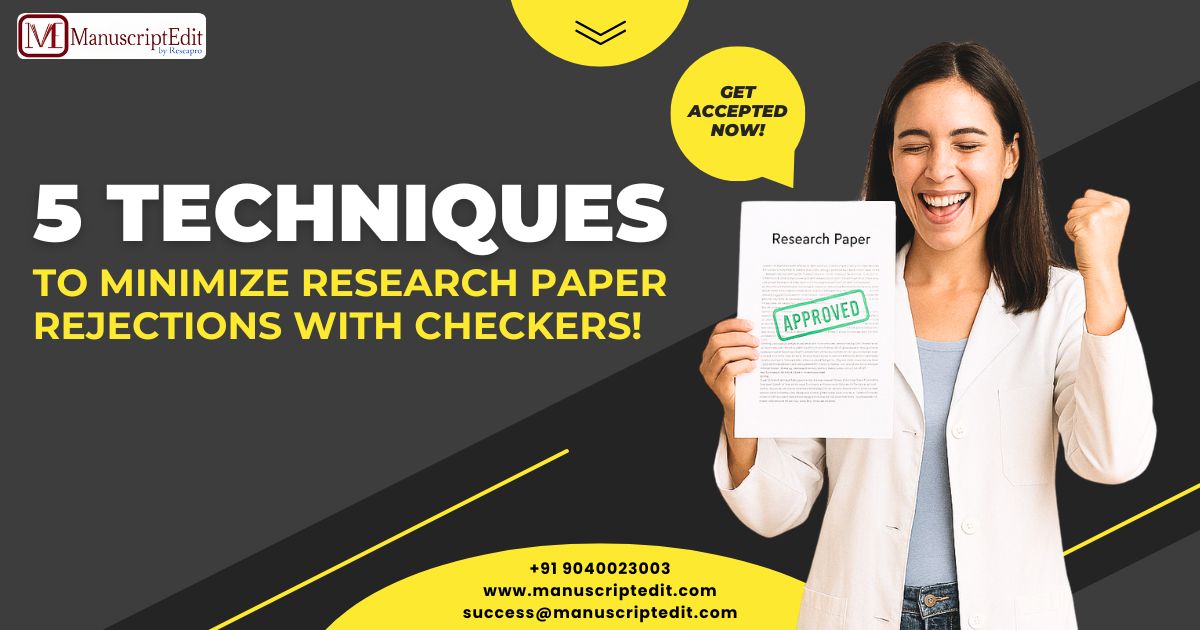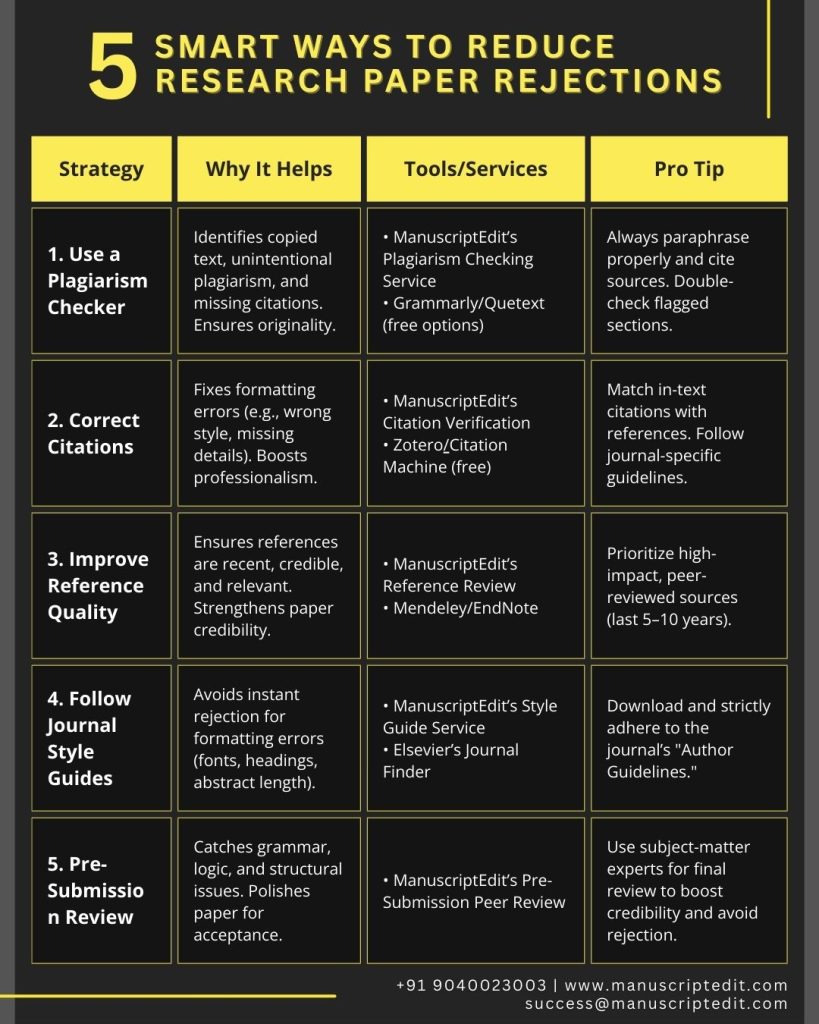Did you know that over 40% of research articles face research paper rejections at the journal submission stage? To your surprise, most rejections do not occur because of poor research. Instead, they occur due to frequent errors such as plagiarism, mis-citations, poor references, or failure to adhere to formatting guidelines. These preventable mistakes can be corrected before submission if you have the right tools and services.

This post will present five intelligent and straightforward ways to prevent such errors. With the assistance of plagiarism detectors, citation software, and organizations such as ManuscriptEdit, you can significantly improve the prospects of getting your work accepted and your research article journal-ready.
5 Smart Ways to Reduce Research Paper Rejections

1. Use a Plagiarism Checker to Avoid Research Paper Rejection
Plagiarism is among the significant reasons journals return papers. Even unintentional plagiarism, copying sentences or phrases without proper citation, will be considered plagiarism. Journals now use sophisticated plagiarism detection software, so it’s a good practice on your part to do the same before submission.
Why it helps:
- It identifies copied or matching text from another published source.
- It indicates unintentional plagiarism, for example, inaccurate paraphrasing or omitted citations.
- You may correct these errors prior to presenting your paper to the journal.
What can help:
- ManuscriptEdit’s Plagiarism Checking Services: ManscriptEdit thoroughly examines research papers by checking for plagiarism and cross-referencing content against established publications and digital sources to ensure originality.
- Free services like Grammarly or Quetext are excellent for simple checks and are particularly suitable for students with constrained budgets.
Tip: Always paraphrase well and quote the source. Having a plagiarism checker provides peace of mind and indicates that your work is original and ethical.
2. Correct Citations to Reduce the Risk of Research Paper Rejection
Most papers are rejected due to citation problems. These include missing page numbers, incorrect author names, incorrect dates, or failing to use the journal’s citation style (e.g., APA, MLA, Vancouver, etc.). Such minor errors can make your paper appear sloppy.
Why it helps:
- It ensures all references and citations are in the right style.
- It identifies missing citations or incorrect formatting.
- It provides your paper with a professional and clean appearance.
What can help:
- ManuscriptEdit’s Citation Verification Service: Our academic experts meticulously review all citations and references to ensure strict compliance with journal formatting guidelines and publication standards.
- Zotero or Citation Machine: These free programs can easily create references in various styles.
Tip: Always correlate in-text citations with your reference list. Precise, accurate citations indicate attention to detail, which reviewers value.
3. Enhance Reference Quality
Good references are the strength of your research paper. Journals will expect you to use current, relevant, and quality sources. Weak, outdated, broken, or low-impact references can weaken your work.
Why it helps:
- Guarantees that your references are recent, trustworthy, and substantiate your ideas.
- Identifies broken links, incorrect data, or incomplete information.
- Assists you in replacing poor sources with improved ones.
What can help:
- ManuscriptEdit’s Reference Review: Professional editors review your reference list, edit mistakes, and recommend better, high-impact sources.
- Mendeley or EndNote: These tools help you efficiently organize, sort, and maintain your references.
Tip: Attempt to use recent sources (within the past 5–10 years) unless you are referencing classic or seminal studies. Good-quality references enhance the credibility of your paper.
4. Follow Journal Style Guides Strictly
Every journal has some formatting guidelines, which involve page layout, font, reference style, abstract length, and order of sections. If you don’t adhere to these, your paper can be rejected immediately—before peer review.
Why it helps:
- Gives your paper a professional and journal-ready appearance.
- Prevents minor formatting errors such as additional spaces, incorrect headers, or omitted keywords.
- Saves editors time and makes a positive first impression.
What can help:
- ManuscriptEdit’s Style Guide Service: Professionals format your paper per your target journal’s guidelines, including layout, references, and nomenclature.
- Elsevier’s Journal Finder or interactive style guides: Useful for verifying format requirements of particular journals.
Tip: Always download and review the “Author Guidelines” page from your target journal’s website. Correct formatting demonstrates respect for the journal’s standards.
5. Get a Pre-Submission Review
Even after employing all these tools, it’s worth getting a final check by a professional human editor. A fresh eye can spot errors you’ve made and provide useful recommendations to improve your work.
Why it helps:
- Experts can identify confusing sentences, grammatical errors, or logical holes.
- They provide feedback on structure, tone, and flow.
- It helps you submit a clear, accurate, and polished paper.
What can help:
- ManuscriptEdit’s Pre-Submission Review is an end-to-end service that incorporates plagiarism detection, citation improvement, grammar correction, and a general review of the document by subject matter experts.
Tip: Always allow yourself sufficient time to make changes following feedback. Hurrying up against deadlines raises the likelihood of minor errors.
Final Thoughts
Getting research published is as much about having good science as ensuring your writing is clean, ethical, and well-presented. Time-saving gadgets such as plagiarism checkers and citation generators may help avoid rejections. Still, the most assured way to get published is with the assistance of experts and using these tools.
Such services as ManuscriptEdit transcend just basic grammar or citation analysis. They deliver wide-ranging support designed to help you meet a journal’s standard, resolve weaker areas, and represent your findings in optimal style.
Get Rejection-Proof with Your Paper
Make things easy by engaging ManuscriptEdit’s services: Plagiarism Checker, Citation Checker, and Pre-Submission Review Service. Allow details to be covered by specialists to ensure your eyes remain fixed on your study and findings.



